HTC Thunderbolt Review: The First Verizon 4G LTE Smartphone
by Brian Klug on April 27, 2011 12:12 AM EST- Posted in
- Smartphones
- HTC
- Verizon
- LTE
- 4G
- Android
- HTC Thunderbolt
- Mobile
- MDM9600
- MSM8655
Display
The display on the Thunderbolt is 4.3 inches and of the relatively standard WVGA (800x480) sort we’re used to seeing from Android phones. It’s a rather normal LCD-TFT panel, no fancy IPS or SAMOLED+ or Pentile like other phones that are starting to headline. As a result, it doesn’t really impress in the numbers department, delivering relatively middling contrast that isn’t insufficient but doesn’t make it a standout performer by any means.
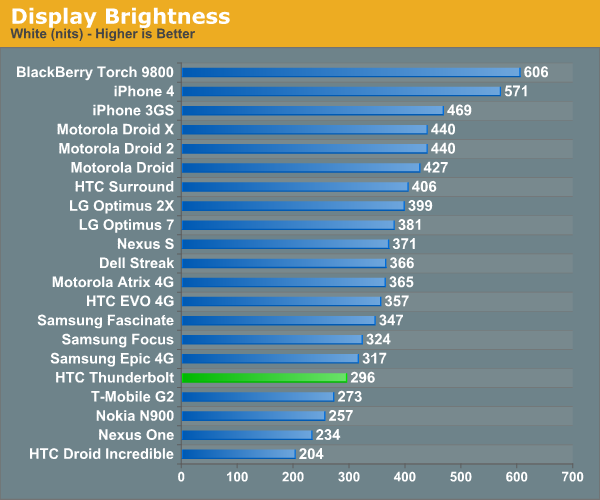
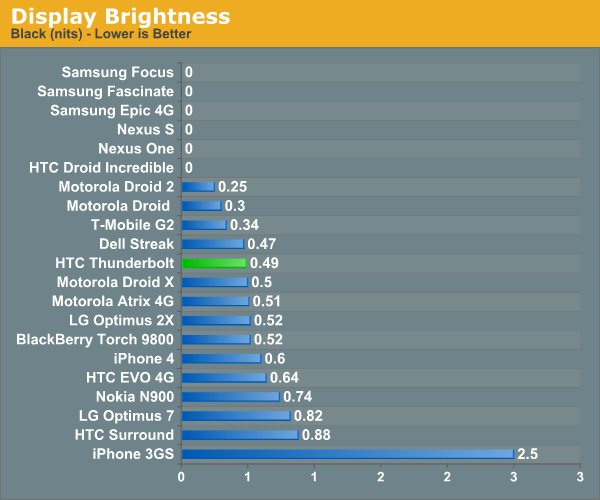

The other part of the picture is that qHD is rapidly becoming a feature that every next generation Android needs to have. In this regard as well as lack of dual core, the Thunderbolt feels a bit like it belongs to this current generation of smartphones rather than the upcoming one.
Absence of qHD isn’t a huge breaking point however since it still isn’t an officially sanctioned Android resolution. Though the official Android screen resolution guidelines have all manners of DPI-independent functionalities and four different display pixel densities, it’s ultimately up to each developer to implement proper pixel density agnosticism properly. In my time with the Arix for example, I’ve already seen a few applications that clearly have hard coded pixel values for UI elements and look weird.
Again by virtue of the Thunderbolt having a relatively ordinary LCD display, it also doesn’t have anything overwhelmingly awesome for viewing angles inside or out.
I grabbed a photo of the Thunderbolt outside right next to a Verizon 4G LTE eNodeB as well, and you can really see how outdoor viewing looks.
One of the only major gripes I have with the Thunderbolt is that there is noticeable light bleed from the capacitive button white LEDs that makes it onto the display surface. At the right angle, you can clearly see the reflection from the two LEDs that light up those buttons.
This is something which used to plague HTC’s designs way, way back, and I’m surprised to see it crop up again. It isn’t super noticeable, but it’s there if you look for it.


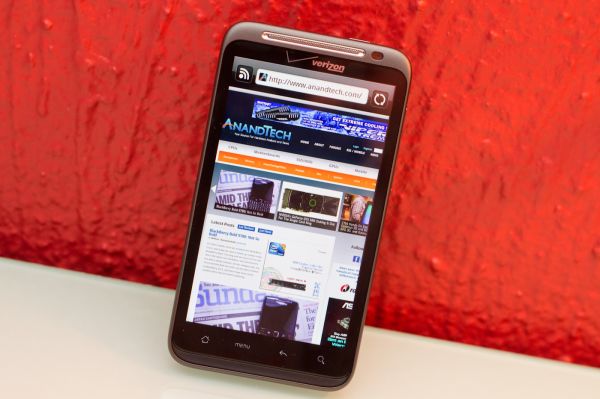
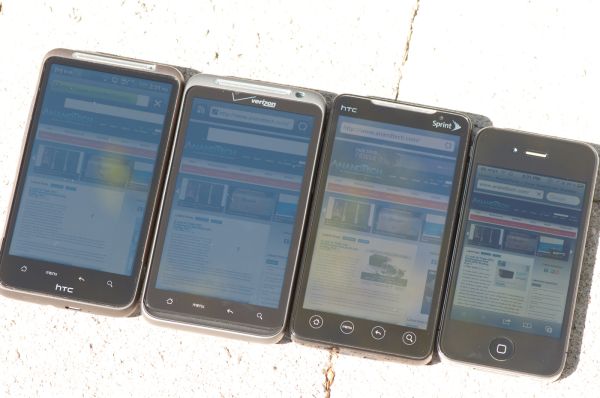
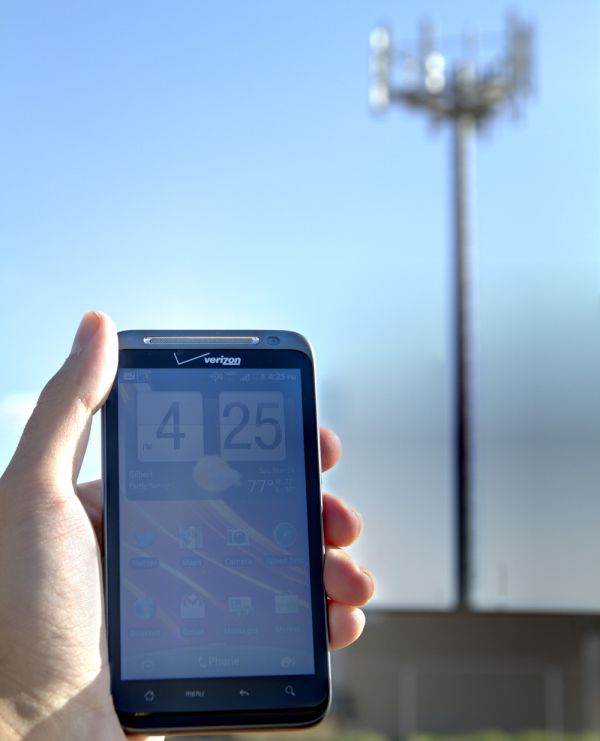
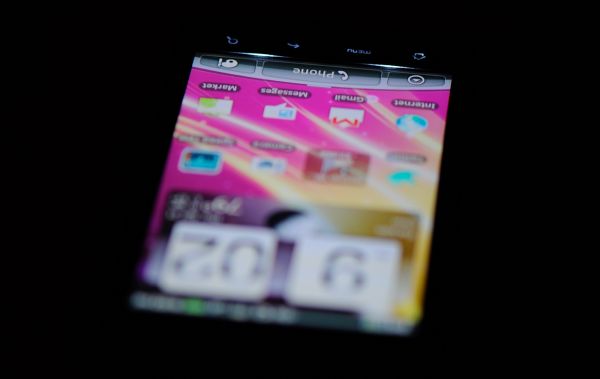








71 Comments
View All Comments
HangFire - Wednesday, April 27, 2011 - link
I credit this to Angry Birds. The bigger the tablet, the better the experience.MilwaukeeMike - Wednesday, April 27, 2011 - link
Well... it comes with a kickstand, clearly they want us to watch movies on them, which means they're not going to get any smaller. Have you ever had one though? It's not that bad. I have a double sized battery on my EVO and the extra width actually makes it easier to take out of my pocket (The ridge by the kickstand makes a little 'handle') and easier to hold sideways.MilwaukeeMike - Wednesday, April 27, 2011 - link
Oh... and a thicker phone means it's more likely in contact with your leg (guys) if in your pocket and increases the chance that you'll feel it when on vibrate.HangFire - Wednesday, April 27, 2011 - link
Brian, great in-depth review.The original Tbolt specs had 8GB of NAND Flash, but mine only reads 4. I've heard a rumor the that half was locked out to help deal with the battery issue, and another rumor that it might be "unlocked" some day. Do you have any info?
Also, some mention should be made of the awful Blockbuster app that comes pre-installed, with permissions to spy on everything, running processes that constantly use data, and cannot be uninstalled short of rooting. HTC and Verizon should be made to understand that such shovelware/crapware is totally unacceptable.
I found the 5MP T-Mobile G2 camera much better indoors/low-light than my Tbolt. Alas, T-Mobile has poor data in my area so I moved over to Verizon and the Tbolt. I think the pointless increase in Megapixels is the cause. I'd like to see better pictures, not better specs.
Brian Klug - Wednesday, April 27, 2011 - link
Interesting, I went with the HTC specifications which list 8 GB, but see what you mean about 4 GB now on this Thunderbolt. Very curious. I don't think the reason could be battery usage since it's nonvolatile, though I've heard lots of discussion about devices with 1 GB+ of RAM using more battery. I'll ask some questions and find out.The funny part about the crapware on the Thunderbolt is that it's actually far less than I see on the Inspire 4G. I haven't seen the Blockbuster app be persistent (though that could be because I haven't launched it), but otherwise yes you're completely right about the preload situation.
-Brian
sooper_anandtech12 - Wednesday, April 27, 2011 - link
Nice to see that the 3.7" 854x480 display on the Droid and Droid 2 still rockin' it as one of THE best displays in the mobile space. As for the push towards qHD displays. To be honest, I would like Motorola and the rest of them to hold off on these qHD displays. They all employ PenTile pixel substructures which effectively means there are less pixels than advertised. Looking at an Atrix display compared to my Droid's display and it's clear the Atrix should have been called Atrocious. The pixelation around widgets and on wallpapers was unacceptable. I haven't seen pixelation like that since AMOLED. Why release qHD PenTile LCDs when Samsung recently admitted PenTile stinks and is going with a normal RGB set up with S-AMOLED+? I'd rather see a nice IPS display like in the LG G2X, running at the antiquated 800x480 than a qHD display running 30% less pixels than the 960x540 that's advertised.mlosee222 - Wednesday, April 27, 2011 - link
Confirmed by threads at xda developers and other sources:http://www.engadget.com/2011/04/27/verizons-lte-ne...
Maybe its just the verizon commercials, but what has me sold is the network. I could honestly care less about the phone compared to the speeds LTE offers. Voice is a secondary consideration to data throughput for me. I would buy the thunderbolt for the network alone.
With that being said, I sincerely hope verizon's LTE isn't as overloaded and useless as T-Mobile's "3G" network is.
hans007 - Wednesday, April 27, 2011 - link
i agree. as someone who just left t-mobile for verizon, their network is terrible now at least for data. their voice isn't really spectacular either.in the bay area, their 3G coverage was really spotty.
and i am also in los angeles a lot and t-mobile has a ton of dead zones. i can't believe they advertise it as 4G as it felt slower than 3G on verizon.
Brian Klug - Wednesday, April 27, 2011 - link
It's a bitter irony really, of course the day after I post everything, eHRPD goes down and takes 4G LTE and 3G EVDO (on eHRPD) with it.If you go into EPST (##778#) and enter MSL (000000), you can change the modem setting under Rev.A to use just HRPD instead of eHRPD. That way, you're anchored through the old 3G data network instead of the common anchor point for EVDO and LTE that appears to be having problems right now.
I've been having sporadic EVDO (eHRPD) connectivity all day with dips to 1x. Unfortunate, but things like this will gradually get better in time.
-Brian
synaesthetic - Thursday, April 28, 2011 - link
Really depends on where you live, and plus you also get what you pay for. T-Mobile is considerably cheaper than Verizon.For slightly less service (assuming I do not buy an LTE device), Verizon charges me $30 more than T-Mobile does. From $65 to $95 for almost exactly the same service (though I lose 50 minutes of anytime minutes on Verizon).
Considering the uncertain future of T-Mobile US, I am considering Verizon as an option, but to me the device--and more specifically, the ROM--is the most important thing as long as my network speeds are decent enough.
For the record, my T-Mobile HSPA+ in downtown Berkeley is excellent, usually 6-7Mbps down and 2-3Mbps up. Absolutely sufficient for my purposes. At home, yeah, in the 'burbs my data speed kind of bites... but I have wifi and much faster wired broadband, why would I bother with using my data plan at home? :D